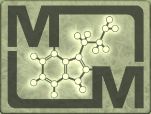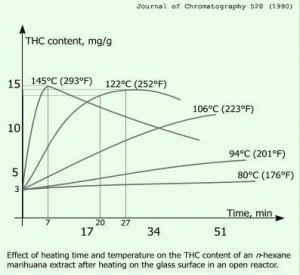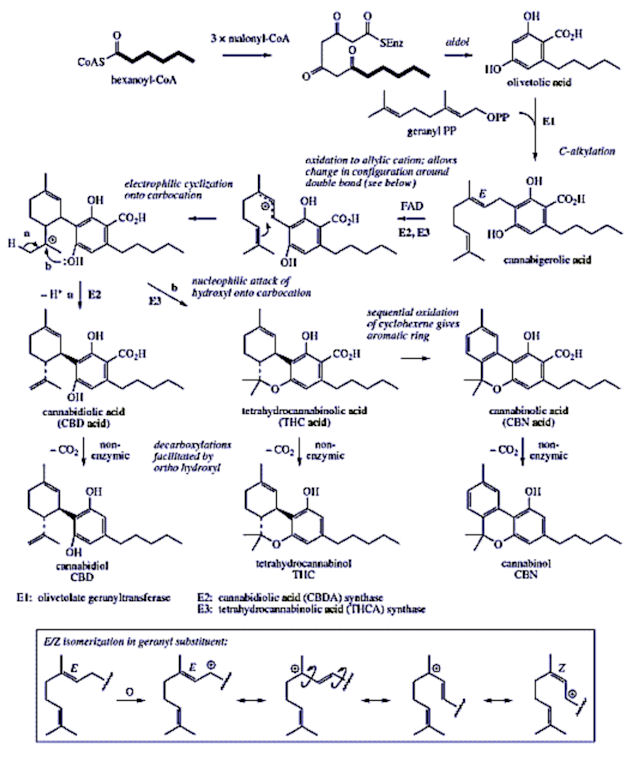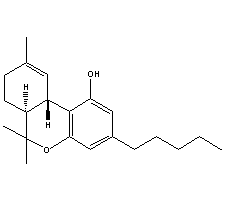 |
MAGISKA MOLEKYLERS WIKI |
THC
Inneh├źll
Generell information
THC ├żr den mest framtr├żdande cannabinoiden i Cannabis.
THC st├źr bakom den huvudsakliga effekten av cannabisruset.
Dekarboxylering av THCA till THC
N├żr cannabis v├żrms upp s├ź omvandlas tetrahydrocannabinolsyra (THCA) till tetrahydrocannabinol (THC). Dekarboxylering ├żr en funktion av v├żrme och temperatur, h├Čgre temperatur g├Čr att dekarboxyleringen tar kort tid, l├żgre temperatur ger l├żngre tid. En l├żngre uppv├żrmning p├ź l├żgre temperatur ├żr mest f├Črdelaktig d├ź man minskar risken f├Čr nedbrytning av THC till CBN.
Metodbeskrivning:
| ŌĆ£ | Preferably, decarboxylation is carried out in a multi-step heating process in which the plant material is:
i) heated to a first temperature for a first (relatively short) time period to evaporate off retained water and allow for uniform heating of the plant material; and ii) the temperature is increased to a second temperature for a second time period (typically longer than the first time period) until at least 95% conversion of the acid cannabinoids to their neutral form has occurred. Preferably the first step is conducted at a temperature in the range of 100┬░ C. to 110┬░ C. for 10ŌĆō20 minutes. More preferably the first temperature is about 105┬░ C. and the first time period is about 15 minutes. If the plant material is derived from cannabis plants having a high CBD content (defined as >90% CBD as a percentage of total cannabinoid content), the second temperature is preferably in the range from 115┬░ C. to 125┬░ C., preferably about 120┬░ C. and the second time period is in the range from 45 to 75 minutes, preferably about 60 minutes. More preferably the second temperature is in the range from 135┬░ C. to 145┬░ C., preferably 140┬░ C. and the second time period is in the range from 15 to 45 minutes, preferably about 30 minutes. In another embodiment, most preferred for a mass of plant material greater than 4 kg, the second temperature is in the range from 140┬░ C. to 150┬░ C., preferably 145┬░ C. and the second time period is in the range from 55ŌĆō90 minutes. The latter conditions are preferred for processing amounts of, for example, 4ŌĆō6 kg of starting plant material and the exact figures, particularly time, may vary slightly with increased mass. If the plant material is derived from cannabis plants having a high THC content (defined as >90% THC as a percentage of total cannabinoid content), the second temperature is preferably in the range of 115┬░ C. to 125┬░ C., typically 120┬░ C., and the second time period is preferably in the range of 45 minutes to 75 minutes, typically about 60 minutes. More preferably the second temperature is in the range of 100┬░ C. to 110┬░ C., typically 105┬░ C., and the second time period is in the range of 60 to 120 minutes. In another embodiment, most preferred for a mass of plant material greater than 4 kg, the second temperature is in the range of 140┬░ C. to 150┬░ C., preferably 145┬░ C., and the second time period is in the range of 45 to 55 minutes. |
ŌĆØ |
Biosyntes av THC
Biosyntesen av THC i Cannabis ser ut enligt f├Čljande diagram (som ├żven visar CBD och CBN):
2019 rapporterades ett genombrott inom konstgjord biosyntes[2][3]. Forskare vid Berkeley har lyckats genmodifiera j├żst till att producera THC och CBD, men kan anv├żndas f├Čr att skapa diverse andra, och nya cannabinoider.
| ŌĆ£ | To produce cannabinoids in yeast (Saccharomyces cerevisiae), UC Berkeley synthetic biologists first engineered yeast's native mevalonate pathway to provide a high flux of geranyl pyrophosphate (GPP) and introduced a hexanoyl-CoA biosynthetic pathway combining genes from five different bacteria. They then introduced Cannabis genes encoding the enzymes involved in olivetolic acid (OA) biosynthesis, a previously undiscovered prenyl transferase enzyme (CsPT4) and cannabinoid synthases. The synthases converted cannabigerolic acid (CBGA) to the cannabinoid acids THCA and CBDA, which, upon exposure to heat, decarboxylate to tetrahydrocannabinol (THC) and cannabidiol (CBD), respectively.
... "The economics look really good," Keasling said. "The cost is competitive or better than that for the plant-derived cannabinoids."
|
ŌĆØ |
Kemi
THC Ut├Čvar sin effekt genom att vara agonist till CB1-receptorer i hj├żrnan.
N├żr THC binder till CB1-receptorer ├żndras aktiviteten hos intracellul├żra enzymer inkluderat cAMP (cykliskt adenosinmonofosfat) vars aktivitet reduceras. Mindre cAMP inneb├żr mindre kinas A. Den reducerade aktiviteten p├źverkar kalium- och kalciumkanalerna och minskar frisl├żppandet av neurotransmittorer. Men processen leder paradoxalt nog ├żnd├ź till ├Čkad frisl├żppning av dopamin. Det beror p├ź att dopaminergiska neuroner inte har CB1-receptorer. Dopaminfrisl├żppningen h├żmmas normalt av GABA och GABA-neuroner har i sin tur CB1-receptorer p├ź axonterminalerna som THC binder till. D├ź h├żmmas frisl├żppandet av GABA vilket resulterar i ├Čkad frisl├żppning av dopamin[5].
LD50-v├żrdet f├Čr oral administrering hos hanr├źttor ├żr ├żr 1270 mg/kg, honr├źttor 730 mg/kg. Inhalerad LD50 ├żr 42 mg/kg f├Čr b├źda k├Čnen.
THC har god l├Čslighet i etanol. ├ännu b├żttre i aceton, butan etc.
| Systematiskt namn | 1-trans-delta^9-tetrahydrocannabinol | |
| Trivialnamn | tetrahydrocannabinol, THC, delta-9-THC | |
| Kemisk formel | C21H30O2 | |
| Sm├żltpunkt | 200 C | |
| Kokpunkt | 155-157 ┬░C (vacuum, 0.07 mbar) | |
| Molmassa | 314.46 g/mol | |
| Densitet | 1.015 +- 0.06 g/cm3 | |
| L├Čslighet | L├żs under extrahering |
Vattenl├Čslighet: 0.28 g/100 ml vid 23 C
Refraktivt index (uppskattat): 1.528 +- 0.02
Ytsp├żnning (uppskattat): 35.0 +- 3.0 dyne/cm
Tr├źdar p├ź Magiska Molekyler om THC
Extraktion, isomerisering, acetylisering av THC
Externa l├żnkar
- Ōåæ CannabisChris: Decarboxylation of cannabis: scientific info about temps and times
- Ōåæ Complete biosynthesis of cannabinoids and their unnatural analogues in yeast (Luo, 2019)
- Ōåæ Scientific American 2019-02-27: Rising High: GM Yeast Generates Known and Novel Marijuana Compounds
- Ōåæ Science Daily 2019-02-27: Yeast produce low-cost, high-quality cannabinoids
- Ōåæ d9-tetrahydrocannabinol is a full agonist at CB1 receptors on GABA neuron axon terminals in the hippocampus (Laaris, 2011)















